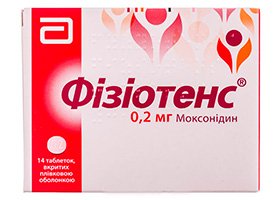
All iLive content is medically reviewed or fact checked to ensure as much factual accuracy as possible.
We have strict sourcing guidelines and only link to reputable media sites, academic research institutions and, whenever possible, medically peer reviewed studies. Note that the numbers in parentheses ([1], [2], etc.) are clickable links to these studies.
If you feel that any of our content is inaccurate, out-of-date, or otherwise questionable, please select it and press Ctrl + Enter.
Physiotensis
Medical expert of the article
Last reviewed: 04.07.2025

Physiotens is an antihypertensive drug. Its active component directly affects the work of imidazoline endings of the central nervous system, which are located inside the medulla oblongata. As a result of this action, the activity of the sympathetic nervous system is weakened and blood pressure indicators are lowered.
Imidazole has a weak affinity for α-adrenergic receptors, so the negative symptoms that occur quite frequently (strong sedative effect and dry mucous membranes) almost never appear when it is administered.
 [ 1 ]
[ 1 ]
ATC classification
Active ingredients
Pharmacological group
Pharmachologic effect
Indications Physiotensis
It is used for increased blood pressure values.
Release form
The medicinal substance is released in tablets (14 pieces in a blister pack). In a box - 1, 2 or 7 packs.
Pharmacodynamics
Moxonidine is considered a highly effective hypotensive agent. Existing experimental data demonstrate that the CNS is the area of hypotensive activity of moxonidine. The component is a selective agonist of imidazoline endings. These endings, sensitive to imidazoline, are located within the rostral part of the ventrolateral region of the medulla oblongata (it is considered the center of regulation of sympathetic PNS activity).
After using moxonidine, there is a decrease in peripheral vascular resistance, which leads to a decrease in blood pressure values. The hypotensive effect of the substance was found in 2-blind, randomized, placebo-controlled tests. The information obtained allows us to conclude that the use of an angiotensin-2 antagonist in combination with moxonidine in people with increased blood pressure and left ventricular hypertrophy with the same decrease in blood pressure levels allowed more effective potentiation of left ventricular hypertrophy regression compared to a free combination of a thiazide with a Ca channel blocker.
Therapeutic trials lasting 2 months showed that, compared with placebo, the drug increased insulin sensitivity index values by +21% in obese individuals with moderate hypertension and insulin resistance.
Pharmacokinetics
Taking into account food intake, 60 minutes after the drug administration, its blood Cmax values are noted. Approximately 7% is synthesized with intraplasmic protein.
Within the body, it undergoes metabolism with the formation of guanine derivatives, as well as 4,5-dihydromoxonidine (excreted after 5 hours). In this case, moxonidine is excreted through the kidneys within 24 hours.
Dosing and administration
The tablets can be taken without reference to meals. The required dose per day is 0.2-0.6 mg of the medication (the dosage is taken in 2 doses). A single dose may include no more than 0.4 mg of Physiotens.
In case of diseases affecting the kidneys, no more than 0.2 mg of the drug can be administered per single use, and no more than 0.4 mg per day.
Use Physiotensis during pregnancy
There is no information regarding the use of moxonidine in pregnant women. Animal testing has shown embryotoxic effects, but the potential risk to humans is unknown. It is prohibited to prescribe Physiotens during pregnancy unless absolutely necessary.
Moxonidine is able to pass into mother's milk, which is why it is prohibited to use it during breastfeeding. If it is absolutely necessary to use the drug, you should stop breastfeeding.
Contraindications
Among the contraindications:
- severe intolerance or allergy associated with the elements of the medication;
- bradycardia or heart failure;
- diseases affecting the kidneys or liver;
- SSSU.
Side effects Physiotensis
Main side effects:
- dryness affecting the mucous membranes;
- feeling of weakness and bradycardia;
- decrease in blood pressure values;
- nausea;
- epidermal manifestations of allergy.
After the first 2 weeks of using the drug, the frequency and severity of negative symptoms decreases.
Storage conditions
Physiotens is kept in a place protected from sunlight at a standard temperature.
Shelf life
Physiotens can be used within a 2-year period from the date of manufacture of the medicine.
Application for children
It should not be prescribed in pediatrics (children under 18 years of age).
Analogues
Analogues of the drug are Moxogam, Estupik with Tenaxum and Clonidine.
Reviews
Physiotens receives positive reviews. Regular long-term use of the drug leads to an effective reduction in blood pressure. Of the negative aspects, side effects are noted (usually dry mouth mucous membranes and headaches), but they gradually disappear after the first weeks of use.
Comments on medical forums particularly note that taking the medication should not be stopped abruptly, and that skipping doses should also be avoided.
Manufacturer
Attention!
To simplify the perception of information, this instruction for use of the drug "Physiotensis" translated and presented in a special form on the basis of the official instructions for medical use of the drug. Before use read the annotation that came directly to medicines.
Description provided for informational purposes and is not a guide to self-healing. The need for this drug, the purpose of the treatment regimen, methods and dose of the drug is determined solely by the attending physician. Self-medication is dangerous for your health.

